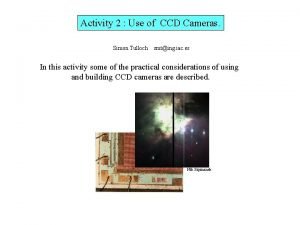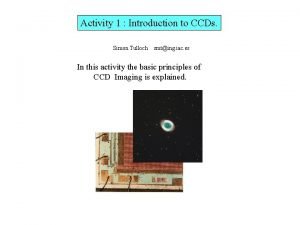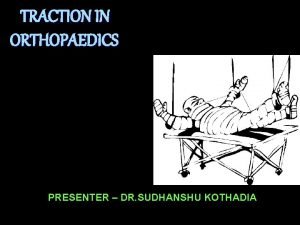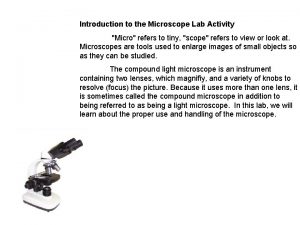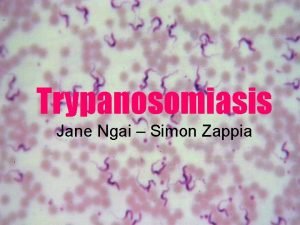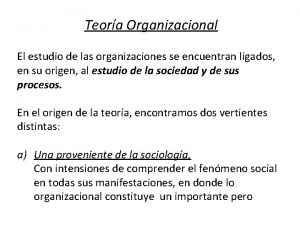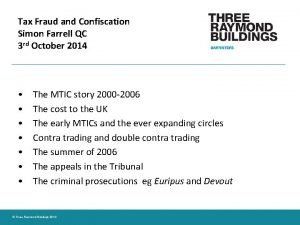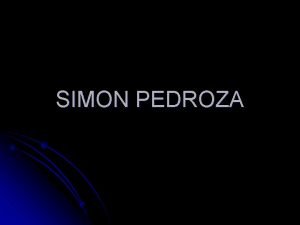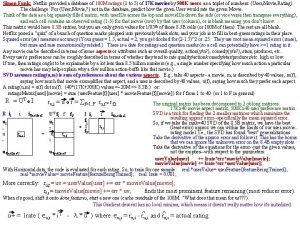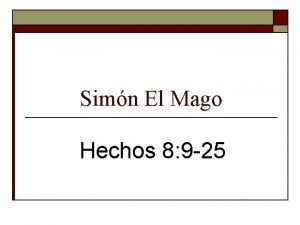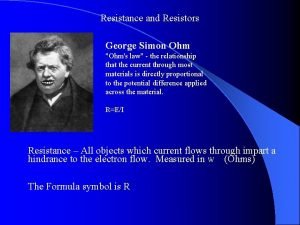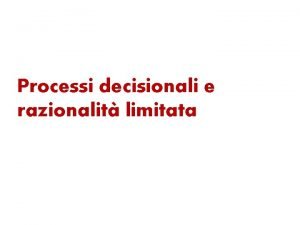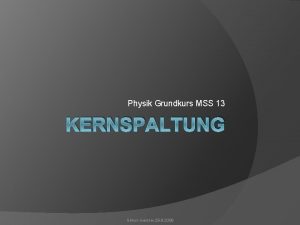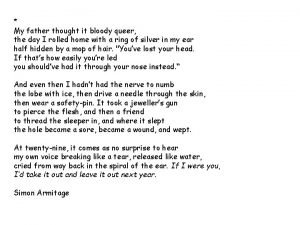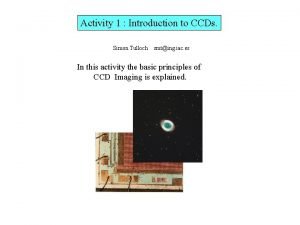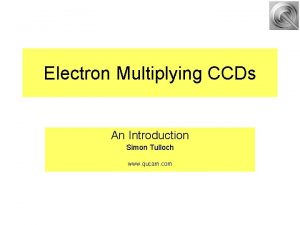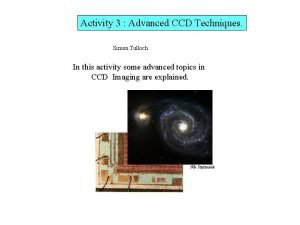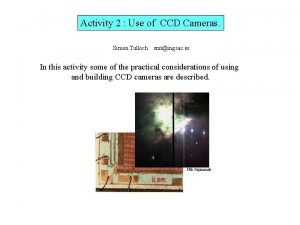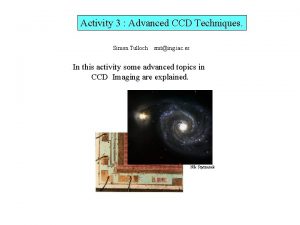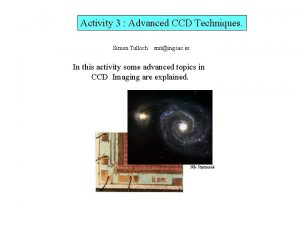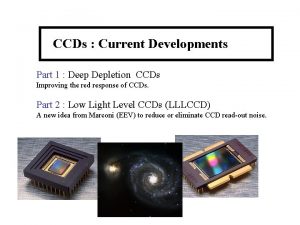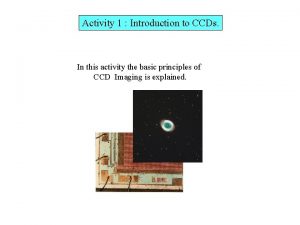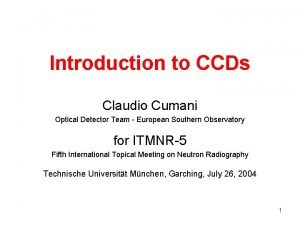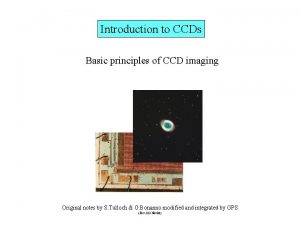Activity 1 Introduction to CCDs Simon Tulloch In






















































- Slides: 54

Activity 1 : Introduction to CCDs. Simon Tulloch In this activity the basic principles of CCD Imaging is explained.

What is a CCD ? Charge Coupled Devices (CCDs) were invented in the 1970 s and originally found application as memory devices. Their light sensitive properties were quickly exploited for imaging applications and they produced a major revolution in Astronomy. They improved the light gathering power of telescopes by almost two orders of magnitude. Nowadays an amateur astronomer with a CCD camera and a 15 cm telescope can collect as much light as an astronomer of the 1960 s equipped with a photographic plate and a 1 m telescope. CCDs work by converting light into a pattern of electronic charge in a silicon chip. This pattern of charge is converted into a video waveform, digitised and stored as an image file on a computer.

Photoelectric Effect. ton pho Increasing energy The effect is fundamental to the operation of a CCD. Atoms in a silicon crystal have electrons arranged in discrete energy bands. The lower energy band is called the Valence Band, the upper band is the Conduction Band. Most of the electrons occupy the Valence band but can be excited into the conduction band by heating or by the absorption of a photon. The energy required for this transition is 1. 26 electron volts. Once in this conduction band the electron is free to move about in the lattice of the silicon crystal. It leaves behind a ‘hole’ in the valence band which acts like a positively charged carrier. In the absence of an external electric field the hole and electron will quickly re-combine and be lost. In a CCD an electric field is introduced to sweep these charge carriers apart and prevent recombination. Conduction Band 1. 26 e. V Valence Band Hole Electron Thermally generated electrons are indistinguishable from photo-generated electrons. They constitute a noise source known as ‘Dark Current’ and it is important that CCDs are kept cold to reduce their number. 1. 26 e. V corresponds to the energy of light with a wavelength of 1 mm. Beyond this wavelength silicon becomes transparent and CCDs constructed from silicon become insensitive.

CCD Analogy A common analogy for the operation of a CCD is as follows: An number of buckets (Pixels) are distributed across a field (Focal Plane of a telescope) in a square array. The buckets are placed on top of a series of parallel conveyor belts and collect rain fall (Photons) across the field. The conveyor belts are initially stationary, while the rain slowly fills the buckets (During the course of the exposure). Once the rain stops (The camera shutter closes) the conveyor belts start turning and transfer the buckets of rain , one by one , to a measuring cylinder (Electronic Amplifier) at the corner of the field (at the corner of the CCD) The animation in the following slides demonstrates how the conveyor belts work.

CCD Analogy RAIN (PHOTONS) VERTICAL CONVEYOR BELTS (CCD COLUMNS) BUCKETS (PIXELS) HORIZONTAL CONVEYOR BELT (SERIAL REGISTER) MEASURING CYLINDER (OUTPUT AMPLIFIER)

Exposure finished, buckets now contain samples of rain.

Conveyor belt starts turning and transfers buckets. Rain collected on the vertical conveyor is tipped into buckets on the horizontal conveyor.

Vertical conveyor stops. Horizontal conveyor starts up and tips each bucket in turn into the measuring cylinder.

After each bucket has been measured, the measuring cylinder is emptied , ready for the next bucket load. `







A new set of empty buckets is set up on the horizontal conveyor and the process is repeated.

















Eventually all the buckets have been measured, the CCD has been read out.

Structure of a CCD 1. The image area of the CCD is positioned at the focal plane of the telescope. An image then builds up that consists of a pattern of electric charge. At the end of the exposure this pattern is then transferred, pixel at a time, by way of the serial register to the on-chip amplifier. Electrical connections are made to the outside world via a series of bond pads and thin gold wires positioned around the chip periphery. Image area Metal, ceramic or plastic package Connection pins Gold bond wires Bond pads Silicon chip On-chip amplifier Serial register

Structure of a CCD 2. CCDs are manufactured on silicon wafers using the same photo-lithographic techniques used to manufacture computer chips. Scientific CCDs are very big , only a few can be fitted onto a wafer. This is one reason that they are so costly. The photo below shows a silicon wafer with three large CCDs and assorted smaller devices. A CCD has been produced by Philips that fills an entire 6 inch wafer! It is the worlds largest integrated circuit. Don Groom LBNL

Structure of a CCD 3. The diagram shows a small section (a few pixels) of the image area of a CCD. This pattern is reapeated. Channel stops to define the columns of the image Plan View One pixel Cross section Transparent horizontal electrodes to define the pixels vertically. Also used to transfer the charge during readout Electrode Insulating oxide n-type silicon p-type silicon Every third electrode is connected together. Bus wires running down the edge of the chip make the connection. The channel stops are formed from high concentrations of Boron in the silicon.

Structure of a CCD 4. Below the image area (the area containing the horizontal electrodes) is the ‘Serial register’. This also consists of a group of small surface electrodes. There are three electrodes for every column of the image area Image Area On-chip amplifier at end of the serial register Serial Register Cross section of serial register Once again every third electrode is in the serial register connected together.

Structure of a CCD 5. Photomicrograph of a corner of an EEV CCD. 160 mm Bus wires Serial Register Read Out Amplifier Edge of Silicon Image Area The serial register is bent double to move the output amplifier away from the edge of the chip. This useful if the CCD is to be used as part of a mosaic. The arrows indicate how charge is transferred through the device.

Structure of a CCD 6. Photomicrograph of the on-chip amplifier of a Tektronix CCD and its circuit diagram. 20 mm Output Drain (OD) Gate of Output Transistor Output Source (OS) SW R RD OD Output Node Reset Transistor Reset Drain (RD) Summing Well R Output Node Serial Register Electrodes OS Summing Well (SW) Last few electrodes in Serial Register Output Transistor Substrate

Electric Field in a CCD 1. Electric potential The n-type layer contains an excess of electrons that diffuse into the p-layer. The p-layer contains an excess of holes that diffuse into the n-layer. This structure is identical to that of a diode junction. The diffusion creates a charge imbalance and induces an internal electric field. The electric potential reaches a maximum just inside the n-layer, and it is here that any photo-generated electrons will collect. All science CCDs have this junction structure, known as a ‘Buried Channel’. It has the advantage of keeping the photo-electrons confined away from the surface of the CCD where they could become trapped. It also reduces the amount of thermally generated noise (dark current). p n Potential along this line shown in graph above. Cross section through the thickness of the CCD

Electric Field in a CCD 2. Electric potential During integration of the image, one of the electrodes in each pixel is held at a positive potential. This further increases the potential in the silicon below that electrode and it is here that the photoelectrons are accumulated. The neighboring electrodes, with their lower potentials, act as potential barriers that define the vertical boundaries of the pixel. The horizontal boundaries are defined by the channel stops. p n Region of maximum potential

Charge Collection in a CCD. Charge packet pixel boundary incoming photons Photons entering the CCD create electron-hole pairs. The electrons are then attracted towards the most positive potential in the device where they create ‘charge packets’. Each packet corresponds to one pixel n-type silicon Electrode Structure p-type silicon Si. O 2 Insulating layer

Charge Transfer in a CCD 1. In the following few slides, the implementation of the ‘conveyor belts’ as actual electronic structures is explained. The charge is moved along these conveyor belts by modulating the voltages on the electrodes positioned on the surface of the CCD. In the following illustrations, electrodes colour coded red are held at a positive potential, those coloured black are held at a negative potential. 1 2 3

Charge Transfer in a CCD 2. +5 V 2 0 V -5 V +5 V 1 0 V -5 V +5 V 3 0 V -5 V 1 2 3 Time-slice shown in diagram

Charge Transfer in a CCD 3. +5 V 2 0 V -5 V +5 V 1 0 V -5 V +5 V 3 0 V -5 V 1 2 3

Charge Transfer in a CCD 4. +5 V 2 0 V -5 V +5 V 1 0 V -5 V +5 V 3 0 V -5 V 1 2 3

Charge Transfer in a CCD 5. +5 V 2 0 V -5 V +5 V 1 0 V -5 V +5 V 3 0 V -5 V 1 2 3

Charge Transfer in a CCD 6. +5 V 2 0 V -5 V +5 V 1 0 V -5 V +5 V 3 0 V -5 V 1 2 3

Charge Transfer in a CCD 7. +5 V 2 Charge packet from subsequent pixel enters from left as first pixel exits to the right. 0 V -5 V +5 V 1 0 V -5 V +5 V 3 0 V -5 V 1 2 3

Charge Transfer in a CCD 8. +5 V 2 0 V -5 V +5 V 1 0 V -5 V +5 V 3 0 V -5 V 1 2 3

On-Chip Amplifier 1. The on-chip amplifier measures each charge packet as it pops out the end of the serial register. +5 V RD and OD are held at constant voltages SW R RD SW 0 V -5 V OD +10 V Reset Transistor Summing Well --end of serial register Output Node Vout Output Transistor (The graphs above show the signal waveforms) OS Vout The measurement process begins with a reset of the ‘reset node’. This removes the charge remaining from the previous pixel. The reset node is in fact a tiny capacitance (< 0. 1 p. F)

On-Chip Amplifier 2. The charge is then transferred onto the Summing Well. Vout is now at the ‘Reference level’ +5 V SW SW R RD 0 V -5 V OD +10 V Reset Transistor Summing Well --end of serial register Output Node Vout Output Transistor OS Vout There is now a wait of up to a few tens of microseconds while external circuitry measures this ‘reference’ level.

On-Chip Amplifier 3. The charge is then transferred onto the output node. Vout now steps down to the ‘Signal level’ +5 V SW SW R RD 0 V -5 V OD +10 V Reset Transistor Summing Well --end of serial register Output Node Vout Output Transistor OS Vout This action is known as the ‘charge dump’ The voltage step in Vout is as much as several m. V for each electron contained in the charge packet.

On-Chip Amplifier 4. Vout is now sampled by external circuitry for up to a few tens of microseconds. +5 V SW SW R RD 0 V -5 V OD +10 V Reset Transistor Summing Well --end of serial register Output Node Vout Output Transistor OS Vout The sample level - reference level will be proportional to the size of the input charge packet.
 Simon tulloch
Simon tulloch Simon tulloch
Simon tulloch Simon tulloch
Simon tulloch Fixed traction vs sliding traction
Fixed traction vs sliding traction Brian tulloch md
Brian tulloch md Reactants products and leftovers
Reactants products and leftovers Activity and activity coefficient
Activity and activity coefficient Aoa project management
Aoa project management Form content and use
Form content and use Activity 2 finding the sequence
Activity 2 finding the sequence Activity 2:
Activity 2: 3
3 Introduction to the microscope lab activity
Introduction to the microscope lab activity Ego defense mechanisms in lord of the flies
Ego defense mechanisms in lord of the flies Introduction of health and fitness
Introduction of health and fitness Chapter 10 section 10.2 meiosis worksheet answer key
Chapter 10 section 10.2 meiosis worksheet answer key Body paragraph
Body paragraph Marketing simon sinek
Marketing simon sinek Universidad mayor de san simon medicina
Universidad mayor de san simon medicina Simon zappia
Simon zappia Simon nørskov thomsen
Simon nørskov thomsen If he....(not study) now he won't have time later
If he....(not study) now he won't have time later The manhunt themes
The manhunt themes Peter occupation
Peter occupation Simon sawed in half
Simon sawed in half Herbert simon aportes a la administración
Herbert simon aportes a la administración Simon farrell qc
Simon farrell qc Analisi mezzi-fini newell e simon
Analisi mezzi-fini newell e simon Simons and chabris study
Simons and chabris study Sole wanderer
Sole wanderer Tedx puget sound
Tedx puget sound Simon pedroza
Simon pedroza Simon medaney
Simon medaney Simon funk
Simon funk You're beautiful simon armitage
You're beautiful simon armitage Hechos 8:22
Hechos 8:22 Simon hustad evjen
Simon hustad evjen Simon dupont
Simon dupont Simon tilley
Simon tilley Carbon composition resistor definition
Carbon composition resistor definition Input_pullup
Input_pullup Remains simon armitage poem
Remains simon armitage poem Annotated remains poem
Annotated remains poem Simon thompson kent
Simon thompson kent Bacon algorithm
Bacon algorithm Chase and simon 1973
Chase and simon 1973 Simon saavedra treuer
Simon saavedra treuer Pengambilan keputusan menurut herbert a ada 3 tahap
Pengambilan keputusan menurut herbert a ada 3 tahap Herbert simon razionalità limitata
Herbert simon razionalità limitata David scott simon
David scott simon Kernfission
Kernfission Simon 2 stage design
Simon 2 stage design Unit of ohm
Unit of ohm My simon.com
My simon.com When was my father thought it written
When was my father thought it written

